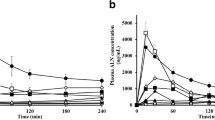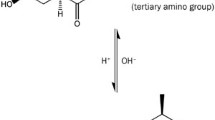Abstract
Purpose
This report describes the effect of rhamnolipids (RLs) on the tight junctions (TJ) of the intestinal epithelium using the rat in-situ closed loop model.
Methods
We investigated the transport of 5 (6)-carboxyfluorescein (CF) and fluorescein isothiocyanate-labeled dextrans with average molecular weights of 4.4 and 10 kDa (FD-4 and FD-10) when co-administered with different concentrations of RLs. Lactate dehydrogenase (LDH) leakage assay and histopathological examination of treated intestinal loops were used to assess potential toxicity of RLs. Further, the effect of kaempferol on accelerating the resealing of the tight junctions in vivo was also investigated
Results
Data shows that administration of different RLs concentrations (1.0–5.0% v/v) increased CF absorption through rat intestine by 2.84- and 15.82-folds with RLs concentrations of 1.0% and 5.0% v/v, respectively. RLs exhibited size-dependent increase on FD-4 and FD-10 absorption. Dosing RLs at 1.0% v/v didn’t cause a significant LDH leakage or histopathological changes to intestinal mucosa compared to higher concentrations, which showed a progressive damaging effect. Using kaempferol, a natural flavonoid that stimulates the assembly of the TJs, proved to enhance the recovery of barrier properties of the intestinal mucosa treated with high concentrations of RLs (2.5% and 5% v/v).
Conclusions
These results collectively illustrate the ability of RLs to enhance oral bioavailability of different molecules across the intestinal epithelial membrane in a concentration- and time-dependent fashion.









Similar content being viewed by others
Abbreviations
- AUC:
-
The total area under the curve
- CF:
-
5(6)-carboxyfluorescein
- Cmax:
-
The peak plasma concentration
- ER:
-
Enhancement ratio
- FD-4:
-
Fluorescein isothiocyanate-labeled dextrans with average molecular weights of 4.4 kDa
- FD-10:
-
Fluorescein isothiocyanate-labeled dextrans with average molecular weights of 10 kDa
- H&E:
-
Hematoxylin and eosin
- i.p:
-
Intraperitoneal
- JAM:
-
Junctional adhesion molecules
- LDH:
-
Lactate dehydrogenase
- PBS:
-
Phosphate-buffered saline
- RLs:
-
Rhamnolipids
- TJs:
-
Tight junctions
- Tmax:
-
Time required to reach Cmax (Tmax)
- ZO:
-
Zonula occludens
References
Lipinski CA, Lombardo F, Dominy BW, Feeney PJ. Experimental and computational approaches to estimate solubility and permeability in drug discovery and development settings. Adv Drug Deliv Rev. 2001;46:3–26.
Miyoshi J, Takai Y. Molecular perspective on tight-junction assembly and epithelial polarity. Adv Drug Deliv Rev. 2005;57:815–55.
Turner JR. Intestinal mucosal barrier function in health and disease. Nat Rev Immunol. 2009;9:799–809.
Kondoh M, Takahashi A, Fujii M, Yagi K, Watanabe Y. A novel strategy for a drug delivery system using a claudin modulator. Biol Pharm Bull. 2006;29:1783–9.
Tomita M, Hayashi M, Awazu S. Absorption-enhancing mechanism of EDTA, caprate, and decanoylcarnitine in Caco-2 cells. J Pharm Sci. 1996;85:608–11.
Lindmark T, Schipper N, Lazorová L, de Boer AG, Artursson P. Absorption enhancement in intestinal epithelial Caco-2 monolayers by sodium caprate: assessment of molecular weight dependence and demonstration of transport routes. J Drug Target. 1998;5:215–23.
E.K. Anderberg, C. Nyström, P. Artursson. Epithelial transport of drugs in cell culture VII: Effects of pharmaceutical surfactant excipients and bile acids on transepithelial permeability in monolayers of human intestinal epithelial (Caco-2) cells. J Pharm Sci 81 (1992), 79–87.
Ranaldi G, Marigliano I, Vespignani I, Perozzi G, Sambuy Y. The effect of chitosan and other polycations on tight junction permeability in the human intestinal Caco-2 cell line. J Nutr Biochem. 2002;13:157–67.
Loftsson T, Vogensen SB, Brewster ME, Konrádsdóttir F. Effects of cyclodextrins on drug delivery through biological membranes. J Pharm Sci. 2007;96:2532–46.
Numata N, Takahashi K, Mizuno N, Utoguchi N, Watanabe Y, Matsumoto M, et al. Improvement of intestinal absorption of macromolecules by nitric oxide donor. J Pharm Sci. 2000;89:1296–304.
Swenson ES, Curatolo WJ. Intestinal permeability enhancement for proteins, peptides and other polar drugs: mechanisms and potential toxicity. Adv Drug Deliv Rev. 1992;8:39–92.
Sakai K, Kutsuna TM, Nishino T, Fujihara Y, Yata N. Contribution of calcium ion sequestration by polyoxyethylated nonionic surfactants to the enhanced colonic absorption of p-aminobenzoic acid. J Pharm Sci. 1986;75:387–90.
Lindmark T, Kimura Y, Artursson P. Absorption enhancement through intracellular regulation of tight junction permeability by medium chain fatty acids in Caco-2 cells. J Pharmacol Exp Ther. 1998;284:362–9.
McEwan GT, Jepson MA, Hirst BH, Simmons NL. Polycation-induced enhancement of epithelial paracellular permeability is independent of tight junctional characteristics. Biochim Biophys Acta. 1993;1148:51–60.
Salamat-Miller N, Johnston TP. Current strategies used to enhance the paracellular transport of therapeutic polypeptides across the intestinal epithelium. Int J Pharm. 2005;294:201–16.
D.E. Otzen. Biosurfactants and surfactants interacting with membranes and proteins: same but different?, Biochim Biophys Acta S0005-2736 (2016), 30326–30321.
Soberón-Chávez G, Lépine F, Déziel E. Production of rhamnolipids by Pseudomonas Aeruginosa. Appl Microbiol Biotechnol. 2005;68:718–25.
Wallace CJ, Medina SH, ElSayed ME. Effect of rhamnolipids on permeability across Caco-2 cell monolayers. Pharm Res. 2014;31:887–94.
Suzuki T, Tanabe S, Hara H. Kaempferol enhances intestinal barrier function through the cytoskeletal association and expression of tight junction proteins in Caco-2 cells. J Nutr. 2011;141:87–94.
Hierholzer C, Kalff JC, Audolfsson G, Billiar TR, Tweardy DJ, Bauer AJ. Molecular and functional contractile sequelae of rat intestinal ischemia/reperfusion injury. Transplantation. 1999;68:1244–54.
L. Zulianello, C. Canard, T. Köhler, D. Caille, J-S. Lacroix, P. Meda. Rhamnolipids are virulence factors that promote early infiltration of primary human airway epithelia by Pseudomonas Aeruginosa. Infect Immun 74 (2006), 3134–3147.
E. Vikström, L. Bui, P. Konradsson, K-E. Magnusson. The junctional integrity of epithelial cells is modulated by Pseudomonas Aeruginosa quorum sensing molecule through phosphorylation-dependent mechanisms. Exp Cell Res 315 (2009), 313–326.
Artursson P, Lindmark T, Davis SS, Illum L. Effect of chitosan on the permeability of monolayers of intestinal epithelial cells (Caco-2). Pharm Res. 1994;11:1358–61.
Anderberg EK, Nyström C, Artursson P. Epithelial transport of drugs in cell culture VII: effects of pharmaceutical surfactant excipients and bile acids on transepithelial permeability in monolayers of human intestinal epithelial (Caco-2) cells. J Pharm Sci. 81, 1992:879–87.
Rejman J, Di Gioia S, Bragonzi A, Conese M. Pseudomonas Aeruginosa infection destroys the barrier function of lung epithelium and enhances polyplex-mediated transfection. Hum Gene Ther. 2007;18:642–52.
M.J. Briske-Anderson, J.W. Finley, S.M. Newman. The influence of culture time and passage number on the morphological and physiological development of Caco-2 cells. Proceedings of the Society for Experimental Biology and medicine Society for Experimental Biology and medicine (New York, NY), Vol. 214, 1997. Pp. 248-257, Royal Society of Medicine.
Tomita M, Hayashi M, Awazu S. Absorption-enhancing mechanism of sodium caprate and decanoylcarnitine in Caco-2 cells. J Pharmacol Exp Ther. 1995;272:739–43.
Hayashi M, Sakai T, Hasegawa Y, Nishikawahara T, Tomioka H, Iida A, et al. Physiological mechanism for enhancement of paracellular drug transport. J Control Release. 1999;62:141–8.
Murakami M, Kusanoi Y, Takada K, Muranishi S. Assessment of enhancing ability of medium-chain alkyl saccharides as new absorption enhancers in rat rectum. Int J Pharmacol. 1992;79:159–69.
Uchiyama T, Yamamoto A, Hatano H, Fujita T, Muranishi S. Effectiveness and toxicity screening of various absorption enhancers in the large intestine: intestinal absorption of phenol red and protein and phospholipid release from the intestinal membrane. Biol Pharm Bull. 1996;19:1618–21.
Uchiyama T, Sugiyama T, Quan YS, Kotani A, Okada N, Fujita T, et al. Enhanced permeability of insulin across the rat intestinal membrane by various absorption enhancers: their intestinal mucosal toxicity and absorption-enhancing mechanism of n-lauryl-beta-D-maltopyranoside. Aust J Pharm. 1999;51:1241–12450.
Miyamoto M, Natsume H, Iwata S, Ohtake K, Yamaguchi M, Kobayashi D, et al. Improved nasal absorption of drugs using poly-L-arginine: effects of concentration and molecular weight of poly-L-arginine on the nasal absorption of fluorescein isothiocyanate-dextran in rats. Eur J Pharm Biopharm. 2001;52:21–3.
Ohtake K, Maeno T, Ueda H, Ogihara M, Natsume H, Morimoto Y. Poly-L-arginine enhances paracellular permeability via serine-threonine phosphorylation of ZO-1 and tyrosine dephosphorylation of occludin in rabbit nasal epithelium. Pharmacol Res. 2003;20:1838–45.
Ohtake K, Maeno T, Ueda H, Natsume H, Morimoto Y. Poly-Larginine predominantly increases the paracellular permeability of hydrophilic macromolecules across rabbit nasal epithelium in vitro. Pharmacol Res. 2003;20:153–60.
Kondoh M, Masuyama A, Takahashi A, Asano N, Mizuguchi H, Koizumi K, et al. A novel strategy for the enhancement of drug absorption using a claudin modulator. Mol Pharmacol. 2005;67:749–56.
Author information
Authors and Affiliations
Corresponding author
Rights and permissions
About this article
Cite this article
Khafagy, ES., El-Azab, M.F. & ElSayed, M.E.H. Rhamnolipids Enhance in Vivo Oral Bioavailability of Poorly Absorbed Molecules. Pharm Res 34, 2197–2210 (2017). https://doi.org/10.1007/s11095-017-2227-y
Received:
Accepted:
Published:
Issue Date:
DOI: https://doi.org/10.1007/s11095-017-2227-y




